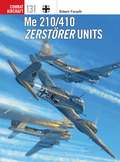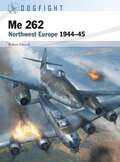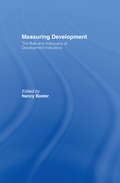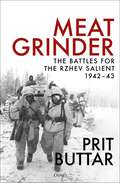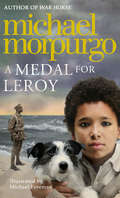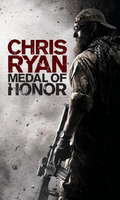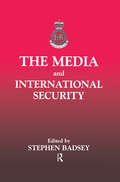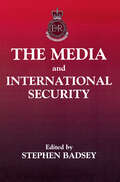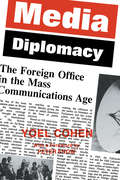- Table View
- List View
Me 210/410 Zerstörer Units (Combat Aircraft)
by Robert ForsythIntended as a progressive development of the twin-engined Bf 110 Zerstörer ('destroyer' or heavy fighter), the Me 210 first took to the air in September 1939. However, due to a lack of sufficient flight-testing before being declared service-ready, the Me 210 suffered from a less than satisfactory reputation in respect to its flight characteristics and weak undercarriage. After enhancements were made to the fuselage and wings, and the power of the plane was increased, the Me 210 became the Me 410 in late 1942. By this stage of the war much was expected of the two types, which were forced to fly in very dangerous skies over North Africa and in the defence of the German homeland. Both aircraft were deployed as heavy fighters, fighter-bombers, reconnaissance platforms and interceptors, seeing service with a number of different units. The Me 410 was fitted with 30 mm cannon, 21 cm underwing mortars and the colossal 5 cm BK cannon that was intended to pack a punch against the USAAF's four-engined bombers which threatened the Reich in large numbers from 1943 onwards. In this title, supported by contemporary photography and full-colour artwork, Robert Forsyth tells the complex story of the Me 210 and 410, detailing their development and assessing their capabilities as combat aircraft.
Me 210/410 Zerstörer Units (Combat Aircraft)
by Robert ForsythIntended as a progressive development of the twin-engined Bf 110 Zerstörer ('destroyer' or heavy fighter), the Me 210 first took to the air in September 1939. However, due to a lack of sufficient flight-testing before being declared service-ready, the Me 210 suffered from a less than satisfactory reputation in respect to its flight characteristics and weak undercarriage. After enhancements were made to the fuselage and wings, and the power of the plane was increased, the Me 210 became the Me 410 in late 1942. By this stage of the war much was expected of the two types, which were forced to fly in very dangerous skies over North Africa and in the defence of the German homeland. Both aircraft were deployed as heavy fighters, fighter-bombers, reconnaissance platforms and interceptors, seeing service with a number of different units. The Me 410 was fitted with 30 mm cannon, 21 cm underwing mortars and the colossal 5 cm BK cannon that was intended to pack a punch against the USAAF's four-engined bombers which threatened the Reich in large numbers from 1943 onwards. In this title, supported by contemporary photography and full-colour artwork, Robert Forsyth tells the complex story of the Me 210 and 410, detailing their development and assessing their capabilities as combat aircraft.
Me 262: Northwest Europe 1944–45 (Dogfight)
by Robert ForsythUsing rare first-hand accounts from Me 262 pilots, Robert Forsyth examines what it was like to fly the world's most advanced interceptor in the deadly skies over Germany in 1944–45. Right from its operational debut in the summer of 1944, the Me 262 outclassed anything the Allies had in terms of speed and firepower ratio, offering a formidable punch with four 30 mm Mk 108 nose-mounted cannon, and a Jumo 004 jet engine. The problem the Luftwaffe faced, however, was one of numbers. Towards the end of the war, availability of machines and trained pilots was scarce, and it is only thanks to the exploits of a handful of veteran Jagdwaffe aces such as Adolf Galland, Walter Krupinski and Johannes Steinhoff, that the aircraft made a significant impact on the air war and was the source of considerable concern to the Allies. Filled with specially commissioned artwork including action-packed ribbon diagrams, battlescenes, armament views and maps, Robert Forsyth offers the definitive technical and historical guide to the state-of-the-art Me 262, using rare photographs and pilots' first-hand accounts.
Me 262: Northwest Europe 1944–45 (Dogfight)
by Robert ForsythUsing rare first-hand accounts from Me 262 pilots, Robert Forsyth examines what it was like to fly the world's most advanced interceptor in the deadly skies over Germany in 1944–45. Right from its operational debut in the summer of 1944, the Me 262 outclassed anything the Allies had in terms of speed and firepower ratio, offering a formidable punch with four 30 mm Mk 108 nose-mounted cannon, and a Jumo 004 jet engine. The problem the Luftwaffe faced, however, was one of numbers. Towards the end of the war, availability of machines and trained pilots was scarce, and it is only thanks to the exploits of a handful of veteran Jagdwaffe aces such as Adolf Galland, Walter Krupinski and Johannes Steinhoff, that the aircraft made a significant impact on the air war and was the source of considerable concern to the Allies. Filled with specially commissioned artwork including action-packed ribbon diagrams, battlescenes, armament views and maps, Robert Forsyth offers the definitive technical and historical guide to the state-of-the-art Me 262, using rare photographs and pilots' first-hand accounts.
Me 262 vs P-51 Mustang: Europe 1944–45 (Duel)
by Robert ForsythArguably two of the finest fighters built during the course of World War II, the Me 262 and P-51 Mustang heralded new dawns in aircraft performance. Making its operational debut in the summer of 1944, and powered by the Jumo 004 jet engine, the Me 262 outclassed Allied planes in terms of speed and firepower ratio, offering a formidable punch with four 30 mm MK 108 nose-mounted cannons. However, in the P-51, fitted with the Rolls-Royce (Packard) Merlin engine and drop tanks, the USAAF finally had a fighter that had the 'legs' to escort its heavy bombers deep into Reich airspace and back. If flown to its strengths, the P-51 was more than capable of taking on the feared Me 262 on an equal footing, despite the differences in power and top speed. Indeed, the Mustang proved to be the Luftwaffe fighter arm's nemesis. When the P-51D sortied over Germany from the summer of 1944 onwards, it shredded through the ill-trained and depleted Gruppen of the Luftwaffe's defence wings.This book examines the two fighters in detail, exploring their history and development and containing accurate descriptions of the combats between the P-51 Mustang and the Me 262 in what were some of the most bitter and large-scale aerial actions fought over Europe in 1944–45.
Me 262 vs P-51 Mustang: Europe 1944–45 (Duel)
by Robert ForsythArguably two of the finest fighters built during the course of World War II, the Me 262 and P-51 Mustang heralded new dawns in aircraft performance. Making its operational debut in the summer of 1944, and powered by the Jumo 004 jet engine, the Me 262 outclassed Allied planes in terms of speed and firepower ratio, offering a formidable punch with four 30 mm MK 108 nose-mounted cannons. However, in the P-51, fitted with the Rolls-Royce (Packard) Merlin engine and drop tanks, the USAAF finally had a fighter that had the 'legs' to escort its heavy bombers deep into Reich airspace and back. If flown to its strengths, the P-51 was more than capable of taking on the feared Me 262 on an equal footing, despite the differences in power and top speed. Indeed, the Mustang proved to be the Luftwaffe fighter arm's nemesis. When the P-51D sortied over Germany from the summer of 1944 onwards, it shredded through the ill-trained and depleted Gruppen of the Luftwaffe's defence wings.This book examines the two fighters in detail, exploring their history and development and containing accurate descriptions of the combats between the P-51 Mustang and the Me 262 in what were some of the most bitter and large-scale aerial actions fought over Europe in 1944–45.
Meade at Gettysburg: A Study in Command (Civil War America)
by Kent Masterson BrownAlthough he took command of the Army of the Potomac only three days before the first shots were fired at Gettysburg, Union general George G. Meade guided his forces to victory in the Civil War's most pivotal battle. Commentators often dismiss Meade when discussing the great leaders of the Civil War. But in this long-anticipated book, Kent Masterson Brown draws on an expansive archive to reappraise Meade's leadership during the Battle of Gettysburg. Using Meade's published and unpublished papers alongside diaries, letters, and memoirs of fellow officers and enlisted men, Brown highlights how Meade's rapid advance of the army to Gettysburg on July 1, his tactical control and coordination of the army in the desperate fighting on July 2, and his determination to hold his positions on July 3 insured victory. Brown argues that supply deficiencies, brought about by the army's unexpected need to advance to Gettysburg, were crippling. In spite of that, Meade pursued Lee's retreating army rapidly, and his decision not to blindly attack Lee's formidable defenses near Williamsport on July 13 was entirely correct in spite of subsequent harsh criticism. Combining compelling narrative with incisive analysis, this finely rendered work of military history deepens our understanding of the Army of the Potomac as well as the machinations of the Gettysburg Campaign, restoring Meade to his rightful place in the Gettysburg narrative.
Measure Of Darkness
by Chris JordanHERE ARE THE FACTS For the parents whose children have been taken, for the brokenlives we piece back together one relentless investigation at a time, our town house is a sanctuary. My name is Alice Crane. I’m just one of a talented team working for Naomi Nantz, the brilliant and very private detective. Today that sanctuary was violated.
Measuring Development: the Role and Adequacy of Development Indicators
by Nancy BasterFirst published in 1972. Routledge is an imprint of Taylor & Francis, an informa company.
Measuring Development: the Role and Adequacy of Development Indicators
by Nancy BasterFirst published in 1972. Routledge is an imprint of Taylor & Francis, an informa company.
Measuring Military Power: The Soviet Air Threat to Europe
by Joshua M. EpsteinJoshua M. Epstein argues that prevailing assumptions about the East- West balance of power rest on erroneous measures of military strength. He develops a method for analyzing military capabilities and applies that general procedure to the Soviet tactical air threat to NATO.Originally published in 1984.The Princeton Legacy Library uses the latest print-on-demand technology to again make available previously out-of-print books from the distinguished backlist of Princeton University Press. These editions preserve the original texts of these important books while presenting them in durable paperback and hardcover editions. The goal of the Princeton Legacy Library is to vastly increase access to the rich scholarly heritage found in the thousands of books published by Princeton University Press since its founding in 1905.
Meat Grinder: The Battles for the Rzhev Salient, 1942–43
by Prit ButtarAn engrossing history of the desperate battles for the Rzhev Salient, a forgotten story brought to life by the harrowing memoirs of German and Russian soldiers.The fighting between the German and Russian armies in the Rzhev Salient during World War II was so grisly, so murderous, and saw such vast losses that the troops called the campaign 'The Meat Grinder'. Though millions of men would fight and die there, the Rzhev Salient does not have the name recognition of Leningrad or Moscow. It was simply a vast tract of forests and swamps in the heart of Mother Russia that has been largely ignored by Western historians…until now. Prit Buttar, a world expert on the Eastern Front during World War II, reveals the depth and depravity of the bitter fighting for the Rzhev Salient in this astonishing new history. He details how the long-ignored region held the promise of a renewed drive on the Soviet capital for the German Army – a chance to turn the tide of war. Using both German and Russian first-hand accounts, Buttar examines the four major offensives launched by the Red Army against the salient, all of which were defeated with heavy losses, exceeding two million killed, wounded or missing, until eventually, the Germans were forced to evacuate the salient in March 1943.Drawing on the latest research, Meat Grinder provides a new study of these horrific battles but also examines how the Red Army did ultimately learn from its colossal failures and how its analysis of these failures at the time helped pave the way for the eventual Soviet victory against Army Group Centre in the summer of 1944, leaving the road to Berlin clear.
Meat Grinder: The Battles for the Rzhev Salient, 1942–43
by Prit ButtarAn engrossing history of the desperate battles for the Rzhev Salient, a forgotten story brought to life by the harrowing memoirs of German and Russian soldiers.The fighting between the German and Russian armies in the Rzhev Salient during World War II was so grisly, so murderous, and saw such vast losses that the troops called the campaign 'The Meat Grinder'. Though millions of men would fight and die there, the Rzhev Salient does not have the name recognition of Leningrad or Moscow. It was simply a vast tract of forests and swamps in the heart of Mother Russia that has been largely ignored by Western historians…until now. Prit Buttar, a world expert on the Eastern Front during World War II, reveals the depth and depravity of the bitter fighting for the Rzhev Salient in this astonishing new history. He details how the long-ignored region held the promise of a renewed drive on the Soviet capital for the German Army – a chance to turn the tide of war. Using both German and Russian first-hand accounts, Buttar examines the four major offensives launched by the Red Army against the salient, all of which were defeated with heavy losses, exceeding two million killed, wounded or missing, until eventually, the Germans were forced to evacuate the salient in March 1943.Drawing on the latest research, Meat Grinder provides a new study of these horrific battles but also examines how the Red Army did ultimately learn from its colossal failures and how its analysis of these failures at the time helped pave the way for the eventual Soviet victory against Army Group Centre in the summer of 1944, leaving the road to Berlin clear.
A Medal for Leroy
by Michael MorpurgoInspired by the true story of Walter Tull, the first black officer in the British army, this is a stunning new novel of identity and loss by Michael Morpurgo, biggest UK children’s author and the bestselling, award-winning writer of War Horse, now a smash West End and Broadway hit as well as an Oscar-nominated movie.
A Medal For Leroy (PDF)
by Michael MorpurgoInspired by the true story of Walter Tull, the first black officer in the British army. A novel about families, identity and loss by bestselling award-winning author of WAR HORSE. Michael doesn’t remember his father, an RAF pilot lost in the war. And his French mother, heartbroken and passionate, doesn’t like to talk about her husband. But then Auntie Snowdrop gives Michael a medal, followed by a photograph, which begin to reveal a hidden history. A story of love and loss. A story that will change everything – and reveal to Michael who he really is…
Medal of Honor: Regular Version
by Peter CollierOn October 25, 2010, Staff Sergeant Salvatore Giunta became the first living person since the Vietnam War to receive the United States’ highest military decoration, and both he and Sergeant Leroy Petry (the second inductee) rightly take their place in the pages of this third edition of Medal of Honor: Portraits of Valor Beyond the Call of Duty. The book includes 144 contemporary portraits of recipients by award-winning photographer Nick Del Calzo and profiles by National Book Award nominee Peter Collier. First published on Veterans Day 2003, this New York Times bestseller has now been updated and augmented to include new essays plus:• Letters from all living presidents • A foreword by Brian Williams • Profiles of Sergeant Giunta and Sergeant Petry There are also essays by Tom Brokaw, Senator John McCain, and Victor Davis Hanson, and a multimedia DVD with historic footage and recipients’ first-person reflections. The Medal of Honor recipients in the book fought in conflicts from World War II to Afghanistan, serving in every branch of the armed services.
Medal of Honor: Fight to Win
by Chris RyanIn this new Chris Ryan adventure, the best soldiers in the world come together to fight Al-Qaeda. It is the early days of the war in Afghanistan. SAS hero, Jock, has never fought alongside America's select Tier 1 Operators before now, but when their mission goes pear-shaped, he will find out just what they are made of... Battling against overwhelming odds in unknown territory, and with the enemy well dug-in, even the most elite soldiers with the most advanced weaponry at their disposal are put to the ultimate test of skill and courage.
The Media and International Security (The Sandhurst Conference Series)
by Stephen BadseyA collection of the papers from the 1995 Sandhurst conference presented by leading members of the armed forces, the media and academia. The conference marked a major advance in British thinking on this very topical and fast-moving subject, bringing together authorities from various fields in a multidisciplinary investigation which has been, and will be of great interest to a wide variety of specialist readers.
The Media and International Security (The Sandhurst Conference Series #Vol. 1)
by Stephen BadseyA collection of the papers from the 1995 Sandhurst conference presented by leading members of the armed forces, the media and academia. The conference marked a major advance in British thinking on this very topical and fast-moving subject, bringing together authorities from various fields in a multidisciplinary investigation which has been, and will be of great interest to a wide variety of specialist readers.
The Media and the Rwanda Genocide
by Allan ThompsonThe news media played a crucial role in the 1994 Rwanda genocide: local media fuelled the killings, while the international media either ignored or seriously misconstrued what was happening.*BR**BR*This is the first book to explore both sides of that media equation. The book examines how local radio and print media were used as a tool of hate by encouraging neighbours to turn against each other. It also presents a critique of international media coverage of the cataclysmic events in Rwanda. Bringing together local reporters and commentators from Rwanda, high-profile Western journalists and leading media theorists, this is the only book to identify and probe the extent of the media's accountability. It also examines deliberations by the International Criminal Tribunal for Rwanda on the role of the media in the genocide. *BR**BR*In writing this startling record of the dangerous negative influence that the media can have, when used as a political tool or when news organisations and journalists fail to live up to their responsibilities, the authors put forward suggestions for the future; outlining how we can avoid censorship and propaganda, and arguing for a new responsibility in media reporting.
Media Diplomacy: The Foreign Office in the Mass Communications Age
by Yoel CohenPublished in 1986, Media Diplomacy is a valuable contribution to the field of Military & Strategic Studies.
Media Diplomacy: The Foreign Office in the Mass Communications Age
by Yoel CohenPublished in 1986, Media Diplomacy is a valuable contribution to the field of Military & Strategic Studies.
Media Strategy and Military Operations in the 21st Century: Mediatizing the Israel Defence Forces (Contemporary Security Studies)
by Michal ShavitThis book applies the concept of mediatization to the contemporary dynamic between war, media and society, with a focus on the Israel Defence Forces (IDF). Since the beginning of the 21st century the IDF has undergone an intensive process of mediatization that has transformed the media into an interpretative grid for many of its military activities and increasingly utilized media to garner public support and construct civilian perceptions of conflict and security through media activity and strategy. This process can be divided into four distinct chronological phases in accordance with the operational challenges confronted by the IDF during this period, from the Al-Aqsa Intifada of 2000, through Israeli unilateral disengagement from Gaza in 2005, and the second Lebanon war of 2006, to the series of Gaza confrontations of 2008-2014. The work shows how the IDF’s media policy evolved from a narrow perception of its role, and separation between operational and media actions to a cohesive and coherently articulated media strategy that is increasingly intertwined with military action and operational strategy and a vital component of strategic military aims and objectives. This strategic stance has led the IDF to adopt a global media perspective using the most advanced new media platforms, designed to influence public opinion and improve national narratives, both in Israel and the international community. By applying the concept of mediatization to the Israeli case, this book fills a research lacuna and offers a new prism for the study of media-military relations in contemporary conflicts. The book will be of much interest to students of civil-military relations, strategic studies, Middle Eastern Studies, media and communication studies, sociology and IR, in general.
Media Strategy and Military Operations in the 21st Century: Mediatizing the Israel Defence Forces (Contemporary Security Studies)
by Michal ShavitThis book applies the concept of mediatization to the contemporary dynamic between war, media and society, with a focus on the Israel Defence Forces (IDF). Since the beginning of the 21st century the IDF has undergone an intensive process of mediatization that has transformed the media into an interpretative grid for many of its military activities and increasingly utilized media to garner public support and construct civilian perceptions of conflict and security through media activity and strategy. This process can be divided into four distinct chronological phases in accordance with the operational challenges confronted by the IDF during this period, from the Al-Aqsa Intifada of 2000, through Israeli unilateral disengagement from Gaza in 2005, and the second Lebanon war of 2006, to the series of Gaza confrontations of 2008-2014. The work shows how the IDF’s media policy evolved from a narrow perception of its role, and separation between operational and media actions to a cohesive and coherently articulated media strategy that is increasingly intertwined with military action and operational strategy and a vital component of strategic military aims and objectives. This strategic stance has led the IDF to adopt a global media perspective using the most advanced new media platforms, designed to influence public opinion and improve national narratives, both in Israel and the international community. By applying the concept of mediatization to the Israeli case, this book fills a research lacuna and offers a new prism for the study of media-military relations in contemporary conflicts. The book will be of much interest to students of civil-military relations, strategic studies, Middle Eastern Studies, media and communication studies, sociology and IR, in general.
Mediating in Cyprus: The Cypriot Communities and the United Nations
by Oliver P. RichmondThe UN peacemaking operation in Cyprus has been one of the longest of its kind, but has resulted in discarded proposals, non-papers or reports. This study investigates the Cypriot parties' views of peacemaking, to shed light on the problem, and on the theoretical debates surrounding mediation.
